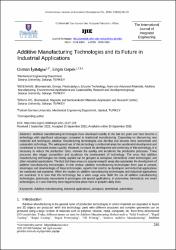| dc.contributor.author | İyibilgin, Osman | |
| dc.contributor.author | Gepek, Engin | |
| dc.date.accessioned | 2022-01-14T06:57:51Z | |
| dc.date.available | 2022-01-14T06:57:51Z | |
| dc.date.issued | 2021 | en_US |
| dc.identifier.citation | İyibilgin, O., & Gepek, E. (2021). Additive Manufacturing Technologies and Its Future in Industrial Applications. International Journal of Integrated Engineering, 13(7), 245-257. | en_US |
| dc.identifier.issn | 2229-838X | |
| dc.identifier.uri | https://hdl.handle.net/20.500.12846/634 | |
| dc.description.abstract | Additive manufacturing technologies have developed rapidly in the last ten years and have become a technology with significant advantages compared to traditional manufacturing. Depending on discovering new materials and techniques, additive manufacturing technologies also develop and become more economical and sustainable technology. The widespread use of this technology in industrial areas has accelerated development and contributed to increased product quality. However, to ensure the development and continuity of this technology, it is necessary to reduce the production costs, increase the quality and accelerate the production processes. These processes also trigger competition and accelerate the development of technology. The areas that additive manufacturing technologies are mostly applied can be grouped as aerospace, biomedical, smart technologies, and other industrial applications. The fact that these areas are popular research areas also accelerates the development of additive manufacturing technologies. In this review, additive manufacturing technologies from past to present, advantages and disadvantages of these technologies, aspects that need to be developed, and industrial applications are examined and explained. When the studies on additive manufacturing technologies and industrial applications are examined, it is seen that this technology has a wide usage area. With the use of additive manufacturing technologies, previously encountered in prototypes and special applications, in automotive, biomedical, and smart technologies, it is seen that they have begun to take place more in people's daily lives. | en_US |
| dc.language.iso | eng | en_US |
| dc.publisher | Universiti Tun Hussein Onn Malaysia | en_US |
| dc.relation.isversionof | 10.30880/ijie.2021.13.07.028 | en_US |
| dc.rights | info:eu-repo/semantics/openAccess | en_US |
| dc.subject | Additive Manufacturing | en_US |
| dc.subject | Industrial Applications | en_US |
| dc.subject | Aerospace | en_US |
| dc.subject | Biomedical | en_US |
| dc.subject | Automotive | en_US |
| dc.subject | Katmanlı Üretim | en_US |
| dc.subject | Endüstriyel Uygulamalar | en_US |
| dc.subject | Havacılık | en_US |
| dc.subject | Biyomedikal | en_US |
| dc.subject | Otomotiv | en_US |
| dc.subject | Additive Fertigung | en_US |
| dc.subject | Industrielle Anwendungen | en_US |
| dc.subject | Luft und Raumfahrt | en_US |
| dc.subject | Biomedizinisch | en_US |
| dc.subject | Automobil | en_US |
| dc.title | Additive manufacturing technologies and its future in industrial applications | en_US |
| dc.type | article | en_US |
| dc.relation.journal | International Journal of Integrated Engineering | en_US |
| dc.contributor.authorID | 0000-0001-7340-8363 | en_US |
| dc.identifier.volume | 13 | en_US |
| dc.identifier.issue | 7 | en_US |
| dc.relation.publicationcategory | Makale - Uluslararası Hakemli Dergi - Kurum Öğretim Elemanı | en_US |
| dc.contributor.department | TAÜ, Mühendislik Fakültesi, Makine Mühendisliği Bölümü | en_US |
| dc.contributor.institutionauthor | Gepek, Engin | |
| dc.identifier.startpage | 245 | en_US |
| dc.identifier.endpage | 257 | en_US |
| dc.identifier.wosquality | N/A | en_US |
| dc.identifier.scopusquality | Q3 | en_US |

















